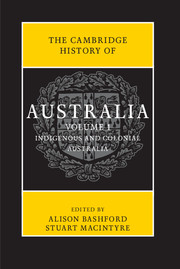Book contents
- Frontmatter
- Contents
- Abbreviations
- List of maps
- List of figures
- List of tables
- Notes on contributors
- Map
- Preface
- Introduction
- PART I
- PART II
- Further reading
- Chronology
- Index
- Frontmatter
- Contents
- Abbreviations
- List of maps
- List of figures
- List of tables
- Notes on contributors
- Map
- Preface
- Introduction
- PART I
- PART II
- 9 Religion
- 10 Culture and media
- 11 Science and medicine
- 12 Society and welfare
- 13 Gender and sexuality
- 14 Indigenous Australia
- 15 Class
- 16 The economy
- 17 Government, law and citizenship
- 18 Education
- 19 The environment
- 20 Travel and connections
- 21 Security
- 22 Australia, Britain and the British Commonwealth
- 23 Australia in the Asia-Pacfic region
- 24 The history anxiety
- Further reading
- Chronology
- Index
15 - Class
from PART II
Published online by Cambridge University Press: 05 November 2013
- Frontmatter
- Contents
- Abbreviations
- List of maps
- List of figures
- List of tables
- Notes on contributors
- Map
- Preface
- Introduction
- PART I
- PART II
- Further reading
- Chronology
- Index
- Frontmatter
- Contents
- Abbreviations
- List of maps
- List of figures
- List of tables
- Notes on contributors
- Map
- Preface
- Introduction
- PART I
- PART II
- 9 Religion
- 10 Culture and media
- 11 Science and medicine
- 12 Society and welfare
- 13 Gender and sexuality
- 14 Indigenous Australia
- 15 Class
- 16 The economy
- 17 Government, law and citizenship
- 18 Education
- 19 The environment
- 20 Travel and connections
- 21 Security
- 22 Australia, Britain and the British Commonwealth
- 23 Australia in the Asia-Pacfic region
- 24 The history anxiety
- Further reading
- Chronology
- Index
Summary
In the Harvester judgment of 1907 Henry Higgins laid down the principles that would guide him as president of the Commonwealth Court of Conciliation and Arbitration. Asked to determine a ‘fair and reasonable’ wage, he decided that those words must mean something more than the level set by the market. It was understandable that an employer, who was ‘a purchaser of labour as a commodity’, should seek to economise on its cost but not ‘at the expense of human life’. A fair and reasonable wage could not depend on whether the profit of the employer was high or low, but must be a first charge on industry. Nor should it be a mere subsistence wage, but rather one that would provide for the ‘normal needs of the average employee, regarded as a human being living in a civilized community’.
At the time Higgins handed down this decision the labour market was crucial to the fortunes of an overwhelming majority of the population. Three-quarters of the 1.5 million men in the workforce and more than four-fifths of the 360,000 women were employees. Higgins took the reliance of most women on the earnings of a male breadwinner as justification for his decision that a man's wage should be sufficient to support a wife and children. Most employees, moreover, were manual workers who worked long hours with no job security. Their vulnerability had been driven home in the Depression of the 1890s when many were thrown out of work.
Higgins was called upon to make his judgment when the new Commonwealth devised measures to reduce this vulnerability. Seeking a remedy for the conflict that occurred as workers and employers organised to increase their bargaining power – and mindful that strikes and lockouts affected the community at large – the parliament created a Court of Conciliation and Arbitration with powers to make legally binding awards.
- Type
- Chapter
- Information
- The Cambridge History of Australia , pp. 358 - 376Publisher: Cambridge University PressPrint publication year: 2013



